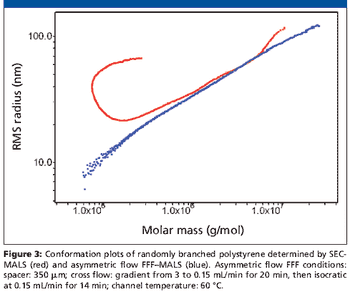Articles by Stepan Podzimek

Analytical size-exclusion chromatography (SEC) often suffers from several limitations. This article shows how some of these limitations can be partly (or even completely) resolved by a multi-angle light scattering (MALS) detector for the determination of molar mass distributions of synthetic and natural polymers.

The macroscopic properties of material based on poly(D,L-lactic-co-glycolic acid) (PLGA) polymers are tunable by molar mass distribution and degree of branching, enabling optimization for applications in the pharmaceutical and medical industries. Size-exclusion chromatography followed by online multi-angle light scattering with intrinsic viscosity detection (SEC–MALS–IV) is an advanced analytical method for determining absolute molar mass distributions, identifying polymer conformation and quantifying branching. SEC–MALS–IV overcomes the errors that can be encountered in molar mass determined by conventional SEC, which arise from chemical composition and molecular structure, and provides comprehensive characterization of PLGA to facilitate the targeted development of optimized polymer.

Two samples of styrene-butadianoene rubbers (SBR) were analyzed by SEC and AF4 coupled with a MALS detector.

Recent development of the instrumentation for asymmetric flow field flow fractionation (FFF) brings new possibilities for the characterization of synthetic and natural polymers with several advantages over traditionally used size exclusion chromatography (SEC). The main difference of asymmetric flow FFF compared to SEC is that the polymer separation takes place in an entirely empty channel, which eliminates undesirable SEC effects such as shearing degradation of polymers with ultra high molar mass, anchoring of branched macromolecules in SEC column packing, and enthalpic interactions of polymer molecules with a stationary phase.

Asymmetric flow field flow fractionation is a type of field flow fractionation (FFF) separation technique. FFF has been co-existing with size exclusion chromatography (SEC) for several decades.

The authors explore how the development of improved light- scattering detection, ethodology, and data interpretation has allowed detailed characterization of polymers used in the paint industry.













